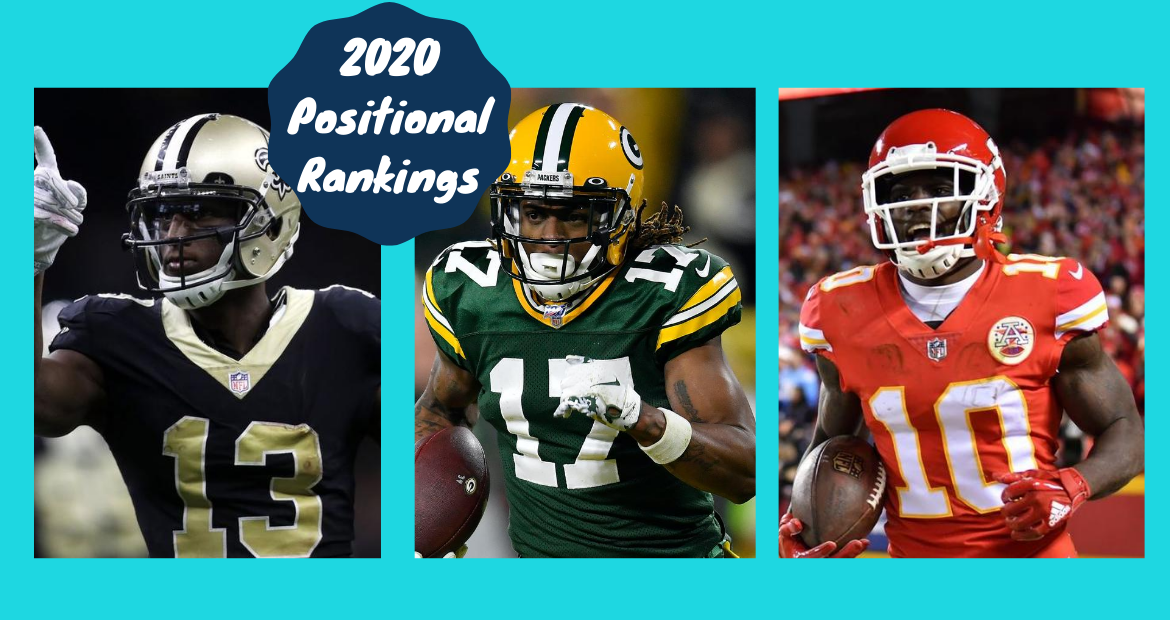
Fitz on Fantasy: 2020 Wide Receiver Rankings, 1-10
Pat Fitzmaurice finished second out of 160 experts in FantasyPros’ 2019 preseason rankings accuracy contest, and he’s now No. 1 in multi-year preseason rankings accuracy for 2017-2019. Fitzmaurice’s full 2020 redraft rankings are posted here, but this series of articles helps explain the thinking behind the rankings. Be sure to check out his already released explainers:
Quarterback Rankings, 1-10
Quarterback Rankings, 11-40
Running Back Rankings, 1-10
Running Back Rankings, 11-30
Running Back Rankings, 31-70
Wide Receiver Rankings, 11-30
For more personalized advice, be sure to check out Pat’s Patreon page where you can have direct access to Pat for your specific fantasy dilemmas.
1. Michael Thomas, Saints
What follows is going to make it seem as if I’m building a case against Thomas as the WR1. Not true. He’s a sublime performer, and he’s my WR1, too.
Thomas finished as the WR6 in both 2017 and 2018, averaging 12.9 and 15.8 fantasy points per game in those two seasons. Last year he was the WR1 by a mile, soaring to 18.8 fantasy points per game. The difference was mostly in target volume. He was targeted 149 times in 2017, 147 times in 2018, and 185 times last year. His target share has gone from 27.8 to 28.3% to 31.8%
It seems unlikely that Thomas could maintain a target share north of 30%. The Saints haven’t had a decent second receiver since Thomas was a rookie paired with Brandin Cooks in 2016, but they added veteran Emmanuel Sanders in the offseason. RB Alvin Kamara missed two games last year and was banged up for much of the year, and TE Jared Cook missed a pair of games, too. The Saints probably won’t need to feed Thomas another 185 targets.
The point isn’t that Thomas should be ranked lower than WR1. The point is that Thomas probably shouldn’t be a top-10 overall pick in draft – not when high-quality, high-volume RBs are so scarce.
Thomas is a magnificent physical specimen and has compiled incredible numbers through his first four seasons. Just realize that he could conceivably finish WR6 again, leaving you wondering why you took him in the middle of the first-round when there were still stud running backs available.
2. Davante Adams, Packers
At least two supersmart fantasy analysts – Justin Boone of theScore.com and Matt Harmon of Yahoo – have Adams ranked RB1 ahead of Michael Thomas. And I get it. It’s not hard to project Adams as the NFL target leader.
With a screaming need at wide receiver, the Packers’ front office inexplicably decided not to draft a single one despite being presented with one of the most highly regarded WR classes in memory. Adams averaged 10.6 targets a game last season, and without a proven sidekick, he could easily average 11 or more targets a game, which would put him in the neighborhood of 176 targets.
Since 2017, Adams has ranked sixth, first and sixth among receivers in fantasy points per game. After two ugly seasons to begin his career, Adams has blossomed into a true star, and the combination of talent and volume could lead to a monster season for him in 2020.
3. Tyreek Hill, Chiefs
Hill is quite possibly the fastest player in the league, he plays with the NFL’s best quarterback, and he’s remarkably good at making contested catches despite measuring 5-10 (which seems generous by at least an inch) and 185 pounds.
My friend Mike Tagliere of FantasyPros.com has noted that Hill has finished as a top-24 receiver in 44.1% of the weeks he’s played over his career, and that he averaged only 7.4 targets per game last year.
Sure, Hill’s production can be a little erratic relative to a human metronome like Michael Thomas. But Hill can be such a difference-maker. He missed four games last year and still managed to turn in stat lines of 11-157-1, 6-140-1, 5-80-2 and 5-67-2. And it’s not as if he stunk otherwise. In his 12 games, the only times he didn’t get at least 55 receiving yards were in the season opener against Jacksonville and in a November game against the Chargers in which he got hurt and played only seven snaps.
In 2018, Hill had 100 yards, a touchdown or both in half of his 16 games, and only twice did he fail to get 50 receiving yards.
I’m all in for the weekly upside here.
4. Julio Jones, Falcons
Some people are allergic to peanuts, some are allergic to shellfish, and some have a touchdown allergy.
OK, that’s mean and not entirely accurate. But it’s definitely a little weird that Julio is this good and somehow isn’t a prolific TD scorer. He’s averaged 6.3 touchdowns a season over his nine-year career. The only time he hit double digits was in 2012, his second year in the league. He’s averaged 0.45 touchdowns a game for his career, so he’s worse than a 50/50 bet to get a TD in any given game.
Still, the TD deficiency is a small quibble with a player who’s averaged 6.3 catches and 96.2 receiving yards per game over nearly a decade.
It is what it is. (Ahem.) Take the receptions and yardage to the bank and hope that you get an unexpected TD bonanza as a bonus.
5. DeAndre Hopkins, Cardinals
Some will view a WR5 ranking for Hopkins as disrespectful. Frankly, I’m worried that I have him ranked too high.
Yes, yes, Hopkins is an electric talent and a craftsman who takes his work to the level of art. He’s too good to completely bust, so you probably won’t curse yourself in December if you spend a second-round pick on Hopkins and he doesn’t meet expectations.
But I do think there’s a very good chance he fails to return a profit on a second-round pick.
Hopkins was a target monster with the Texans, averaging 159.5 targets a season since 2014 and getting at least 150 targets in five consecutive seasons. The target volume figures to come down in Arizona, where Kliff Kingsbury is going to be using a lot of multiple-WR sets that also include Christian Kirk and Larry Fitzgerald. And let’s face it: With COVID-19 altering training camp schedules and wiping out the preseason, this isn’t an ideal year to be a wide receiver changing teams and trying to sync up with a different quarterback.
I’m not a big projections guy, but if I had to set an over/under for Hopkins’ 2020 target total, I’d put it at something like 135. He’s not going to starve with that sort of a target count (135 targets would have ranked 10th among WRs last year), but it’s going to be hard for him to make good on a Round 2 investment.
6. Kenny Golladay, Lions
This kid is the truth. For Golladay to have racked up 1,190 yards and 11 touchdowns in a season where he had to play half of his games without Matthew Stafford at quarterback is nothing short of amazing.
Things were dire enough when journeyman Jeff Driskel had to sub for Stafford in Weeks 10-12. Then Driskel hurt his hamstring, and Detroit’s QB position became a smoldering crater. With David Blough, a CFL-caliber quarterback, running the Lions’ offense for the last five games of the season, Golladay still managed to catch 36 passes for 398 yards and three TDs over that stretch. Prorated, those numbers amount to a 115-1,274-10 season … with a terrible quarterback.
And please, I don’t want to hear, “The ADP gap between Golladay and Marvin Jones shouldn’t be so big.”
Yes, it should be that big. Jones is fine; Golladay is a star. Draft him accordingly.
7. Allen Robinson, Bears
A-Rob was the one element of the Bears’ offense that worked in 2019, finishing WR11 despite the struggles of QB Mitch Trubisky (Sorry, but I refuse to call him “Mitchell” – he hasn’t earned the “ell” yet.) Robinson’s 98-1,147-7 stat line was his best since his watershed 2015 season in Jacksonville, where he had 1,400 yards and 14 touchdowns.
Robinson finally played a full 16-game regular season for the first time since 2016. He only played a few snaps in the 2017 season opener before tearing his ACL, and he missed three games in 2018, his first season in Chicago.
Quarterbacking is still a problem for the Bears, but it might be slightly less of problem. The Bears signed veteran Nick Foles to compete with Trubisky, and though Foles isn’t good enough to be any sort of panacea, he at least gives the Bears a second option so they can at least go with the hot hand. (OK, make that the lukewarm hand.)
I’ve been getting Robinson a lot in drafts where I start RB-RB and want to grab a quality WR in the third round.
8. Chris Godwin, Buccaneers
A lot of the sharps were on Godwin last year, but not even the Godwin honks anticipated the sort of breakout he gave us in 2019. The third-year receiver finished WR2 despite missing the last two games of the season, ending up with 86 receptions for 1,333 yards and nine TDs.
So Godwin’s talent has been established. The QB change in Tampa is the wild card here. On one hand, comparing Tom Brady to Jameis Winston is like comparing a $300 bottle of Louis Roederer Cristal to a $5 bottle of Andre Cold Duck. But on the other hand …
Brady just turned 43. Maybe the champagne has been in the cellar a little too long? Although Brady has long favored his slot receivers, he and Godwin have none of the established chemistry that Brady and Julian Edelman had. And while Winston’s decision-making could be comically bad at time, his YOLO style translated into good WR stats.
Even though I fully buy into Godwin’s abilities, I’m not taking him in the second round, which is where his ADP has been all offseason.
9. Mike Evans, Buccaneers
Six years in the NFL, six 1,000-yard seasons. Evans’ floor is about as safe as they come. But as with Godwin, I’m a little nervous about the Buccaneers’ QB change. (And yes, I realize that being nervous about the transition from Jameis Winston from Tom Brady makes me sound like a moron.)
Evans has typically been about a half-round cheaper than Godwin, though, and I’d rather take Evans at around the 2/3 turn than Godwin in the middle of the second round.
10. JuJu Smith-Schuster, Steelers
JuJu is one of the true pivot players for 2020. It seems like the outcome of his season is going to be particularly consequential in a lot of leagues.
He was typically going early in the second round of 12-team drafts last year, and if he’s as good as we thought he was at this time a year ago, he’s going to turn a tidy profit for his investors this year at his late-third/early-fourth-round ADP.
But is he that good? The one qualm people had last year was that Smith-Schuster’s promising rookie season in 2017 and his WR8 breakout season in 2018 came when Antonio Brown was still on the Steelers, demanding attention from opponents’ top cover men. JuJu’s 2019 campaign was a bitter disappointment to all the fantasy managers who paid a heavy price for him, but Ben Roethlisberger’s elbow injury and JuJu’s foot/knee injuries were valid excuses.
Still, we don’t know whether Smith-Schuster is a true WR1. I’m still pretty optimistic about a guy who had a 1,426-yard season at age 22 and plays with the moxie of a seven-year veteran. Big Ben is healthy again (for now). And while the loquacious AB is gone, precocious youngster Dionte Johnson might be a nice complement for JuJu – good enough to keep opposing defenses from rolling safety help toward JJSS but not quite ready to push for alpha receiver status.
Not sure about you, but I’m back in on JuJu.



